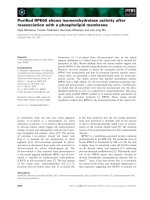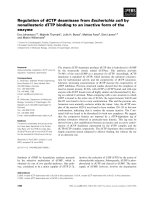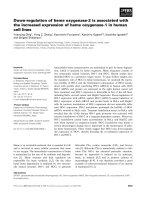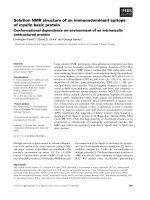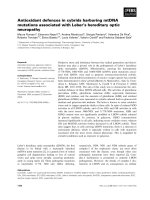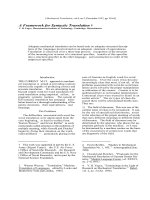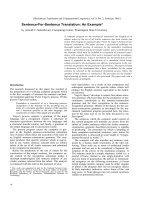Tài liệu Báo cáo khoa học: "Integrating Syntactic Priming into an Incremental Probabilistic Parser, with an Application to Psycholinguistic Modeling" ppt
Bạn đang xem bản rút gọn của tài liệu. Xem và tải ngay bản đầy đủ của tài liệu tại đây (164.29 KB, 8 trang )
Proceedings of the 21st International Conference on Computational Linguistics and 44th Annual Meeting of the ACL, pages 417–424,
Sydney, July 2006.
c
2006 Association for Computational Linguistics
Integrating Syntactic Priming into an Incremental Probabilistic Parser,
with an Application to Psycholinguistic Modeling
Amit Dubey and Frank Keller and Patrick Sturt
Human Communication Research Centre, University of Edinburgh
2 Buccleuch Place, Edinburgh EH8 9LW, UK
{amit.dubey,patrick.sturt,frank.keller}@ed.ac.uk
Abstract
The psycholinguistic literature provides
evidence for syntactic priming, i.e., the
tendency to repeat structures. This pa-
per describes a method for incorporating
priming into an incremental probabilis-
tic parser. Three models are compared,
which involve priming of rules between
sentences, within sentences, and within
coordinate structures. These models sim-
ulate the reading time advantage for par-
allel structures found in human data, and
also yield a small increase in overall pars-
ing accuracy.
1 Introduction
Over the last two decades, the psycholinguistic
literature has provided a wealth of experimental
evidence for syntactic priming, i.e., the tendency
to repeat syntactic structures (e.g., Bock, 1986).
Most work on syntactic priming has been con-
cerned with sentence production; however, recent
studies also demonstrate a preference for struc-
tural repetition in human parsing. This includes
the so-called parallelism effect demonstrated by
Frazier et al. (2000): speakers processes coordi-
nated structures more quickly when the second
conjunct repeats the syntactic structure of the first
conjunct.
Two alternative accounts of the parallelism ef-
fect have been proposed. Dubey et al. (2005) ar-
gue that the effect is simply an instance of a perva-
sive syntactic priming mechanism in human pars-
ing. They provide evidence from a series of cor-
pus studies which show that parallelism is not lim-
ited to co-ordination, but occurs in a wide range
of syntactic structures, both within and between
sentences, as predicted if a general priming mech-
anism is assumed. (They also show this effect is
stronger in coordinate structures, which could ex-
plain Frazier et al.’s (2000) results.)
Frazier and Clifton (2001) propose an alterna-
tive account of the parallelism effect in terms of a
copying mechanism. Unlike priming, this mecha-
nism is highly specialized and only applies to co-
ordinate structures: if the second conjunct is en-
countered, then instead of building new structure,
the language processor simply copies the structure
of the first conjunct; this explains why a speed-
up is observed if the two conjuncts are parallel. If
the copying account is correct, then we would ex-
pect parallelism effects to be restricted to coordi-
nate structures and not to apply in other contexts.
This paper presents a parsing model which im-
plements both the priming mechanism and the
copying mechanism, making it possible to com-
pare their predictions on human reading time data.
Our model also simulates other important aspects
of human parsing: (i) it is broad-coverage, i.e.,
it yields accurate parses for unrestricted input,
and (ii) it processes sentences incrementally, i.e.,
on a word-by-word basis. This general modeling
framework builds on probabilistic accounts of hu-
man parsing as proposed by Jurafsky (1996) and
Crocker and Brants (2000).
A priming-based parser is also interesting from
an engineering point of view. To avoid sparse
data problems, probabilistic parsing models make
strong independence assumptions; in particular,
they generally assume that sentences are indepen-
dent of each other, in spite of corpus evidence for
structural repetition between sentences. We there-
fore expect a parsing model that includes struc-
tural repetition to provide a better fit with real cor-
pus data, resulting in better parsing performance.
A simple and principled approach to handling
structure re-use would be to use adaptation prob-
abilities for probabilistic grammar rules (Church,
2000), analogous to cache probabilities used in
caching language models (Kuhn and de Mori,
1990). This is the approach we will pursue in this
paper.
Dubey et al. (2005) present a corpus study that
demonstrates the existence of parallelism in cor-
pus data. This is an important precondition for un-
derstanding the parallelism effect; however, they
417
do not develop a parsing model that accounts for
the effect, which means they are unable to evaluate
their claims against experimental data. The present
paper overcomes this limitation. In Section 2, we
present a formalization of the priming and copy-
ing models of parallelism and integrate them into
an incremental probabilistic parser. In Section 3,
we evaluate this parser against reading time data
taken from Frazier et al.’s (2000) parallelism ex-
periments. In Section 4, we test the engineering
aspects of our model by demonstrating that a small
increase in parsing accuracy can be obtained with
a parallelism-based model. Section 5 provides an
analysis of the performance of our model, focus-
ing on the role of the distance between prime and
target.
2 Priming Models
We propose three models designed to capture the
different theories of structural repetition discussed
above. To keep our model as simple as possi-
ble, each formulation is based on an unlexicalized
probabilistic context free grammar (PCFG). In this
section, we introduce the models and discuss the
novel techniques used to model structural similar-
ity. We also discuss the design of the probabilistic
parser used to evaluate the models.
2.1 Baseline Model
The unmodified PCFG model serves as the Base-
line. A PCFG assigns trees probabilities by treat-
ing each rule expansion as conditionally indepen-
dent given the parent node. The probability of a
rule LHS → RHS is estimated as:
P(RHS|LHS) =
c(LHS → RHS)
c(LHS)
2.2 Copy Model
The first model we introduce is a probabilistic
variant of Frazier and Clifton’s (2001) copying
mechanism: it models parallelism in coordination
and nothing else. This is achieved by assuming
that the default operation upon observing a coordi-
nator (assumed to be anything with a CC tag, e.g.,
‘and’) is to copy the full subtree of the preced-
ing coordinate sister. Copying impacts on how the
parser works (see Section 2.5), and in a probabilis-
tic setting, it also changes the probability of trees
with parallel coordinated structures. If coordina-
tion is present, the structure of the second item is
either identical to the first, or it is not.
1
Let us call
1
The model only considers two-item coordination or the
last two sisters of multiple-item coordination.
the probability of having a copied tree as p
ident
.
This value may be estimated directly from a cor-
pus using the formula
ˆp
ident
=
c
ident
c
total
Here, c
ident
is the number of coordinate structures
in which the two conjuncts have the same internal
structure and c
total
is the total number of coordi-
nate structures. Note we assume there is only one
parameter p
ident
applicable everywhere (i.e., it has
the same value for all rules).
How is this used in a PCFG parser? Let t
1
and t
2
represent, respectively, the first and second coor-
dinate sisters and let P
PCFG
(t) be the PCFG prob-
ability of an arbitrary subtree t.
Because of the independence assumptions of
the PCFG, we know that p
ident
P
PCFG
(t). One
way to proceed would be to assign a probability
of p
ident
when structures match, and (1 − p
ident
) ·
P
PCFG
(t
2
) when structures do not match. However,
some probability mass is lost this way: there is
a nonzero PCFG probability (namely, P
PCFG
(t
1
))
that the structures match.
In other words, we may have identical subtrees
in two different ways: either due to a copy oper-
ation, or due to a PCFG derivation. If p
copy
is the
probability of a copy operation, we can write this
fact more formally as: p
ident
= P
PCFG
(t
1
) + p
copy
.
Thus, if the structures do match, we assign the
second sister a probability of:
p
copy
+ P
PCFG
(t
1
)
If they do not match, we assign the second con-
junct the following probability:
1 −P
PCFG
(t
1
) − p
copy
1 −P
PCFG
(t
1
)
· P
PCFG
(t
2
)
This accounts for both a copy mismatch and a
PCFG derivation mismatch, and assures the prob-
abilities still sum to one. These probabilities for
parallel and non-parallel coordinate sisters, there-
fore, gives us the basis of the Copy model.
This leaves us with the problem of finding an
estimate for p
copy
. This value is approximated as:
ˆp
copy
= ˆp
ident
−
1
|T
2
|
∑
t∈T
2
P
PCFG
(t)
In this equation, T
2
is the set of all second con-
juncts.
2.3 Between Model
While the Copy model limits itself to parallelism
in coordination, the next two models simulate
structural priming in general. Both are similar in
design, and are based on a simple insight: we may
418
condition a PCFG rule expansion on whether the
rule occurred in some previous context. If Prime is
a binary-valued random variable denoting if a rule
occurred in the context, then we define:
P(RHS|LHS, Prime) =
c(LHS → RHS, Prime)
c(LHS,Prime)
This is essentially an instantiation of Church’s
(2000) adaptation probability, albeit with PCFG
rules instead of words. For our first model, this
context is the previous sentence. Thus, the model
can be said to capture the degree to which rule use
is primed between sentences. We henceforth refer
to this as the Between model. Following the con-
vention in the psycholinguistic literature, we refer
to a rule use in the previous sentence as a ‘prime’,
and a rule use in the current sentence as the ‘tar-
get’. Each rule acts once as a target (i.e., the event
of interest) and once as a prime. We may classify
such adapted probabilities into ‘positive adapta-
tion’, i.e., the probability of a rule given the rule
occurred in the preceding sentence, and ‘negative
adaptation’, i.e., the probability of a rule given that
the rule did not occur in the preceding sentence.
2.4 Within Model
Just as the Between model conditions on rules
from the previous sentence, the Within sentence
model conditions on rules from earlier in the cur-
rent sentence. Each rule acts once as a target, and
possibly several times as a prime (for each subse-
quent rule in the sentence). A rule is considered
‘used’ once the parser passes the word on the left-
most corner of the rule. Because the Within model
is finer grained than the Between model, it can be
used to capture the parallelism effect in coordina-
tion. In other words, this model could explain par-
allelism in coordination as an instance of a more
general priming effect.
2.5 Parser
As our main purpose is to build a psycholinguistic
model of structure repetition, the most important
feature of the parsing model is to build structures
incrementally.
2
Reading time experiments, including the paral-
lelism studies of Frazier et al. (2000), make word-
by-word measurements of the time taken to read
2
In addition to incremental parsing, a characteristic some
of psycholinguistic models of sentence comprehension is to
parse deterministically. While we can compute the best in-
cremental analysis at any point, ours models do not parse de-
terministically. However, following the principles of rational
analysis (Anderson, 1991), our goal is not to mimic the hu-
man parsing mechanism, but rather to create a model of hu-
man parsing behavior.
a novel and a bookwrote
0 3
Terry
4 5 61 2 7
NP
NP
NP
a novel and a bookTerry wrote
0 31 4 5 62 7
NP
NP
NP
Figure 1: Upon encountering a coordinator, the
copy model copies the most likely first conjunct.
sentences. Slower reading times are known to be
correlated with processing difficulty, and faster
reading times (as is the case with parallel struc-
tures) are correlated with processing ease. A prob-
abilistic parser may be considered to be a sen-
tence processing model via a ‘linking hypothesis’,
which links the parser’s word-by-word behavior to
human reading behavior. We discuss this topic in
more detail in Section 3. At this point, it suffices
to say that we require a parser which has the pre-
fix property, i.e., which parses incrementally, from
left to right.
Therefore, we use an Earley-style probabilis-
tic parser, which outputs Viterbi parses (Stolcke,
1995). We have two versions of the parser: one
which parses exhaustively, and a second which
uses a variable width beam, pruning any edges
whose merit is
1
2000
of the best edge. The merit
of an edge is its inside probability times a prior
P(LHS) times a lookahead probability (Roark and
Johnson, 1999). To speed up parsing time, we right
binarize the grammar,
3
remove empty nodes, coin-
dexation and grammatical functions. As our goal
is to create the simplest possible model which can
nonetheless model experimental data, we do not
make any tree modification designed to improve
accuracy (as, e.g., Klein and Manning 2003).
The approach used to implement the Copy
model is to have the parser copy the subtree of the
first conjunct whenever it comes across a CC tag.
Before copying, though, the parser looks ahead to
check if the part-of-speech tags after the CC are
equivalent to those inside the first conjunct. The
copying model is visualized in Figure 1: the top
panel depicts a partially completed edge upon see-
ing a CC tag, and the second panel shows the com-
pleted copying operation. It should be clear that
3
We found that using an unbinarized grammar did not al-
ter the results, at least in the exhaustive parsing case.
419
the copy operation gives the most probable sub-
tree in a given span. To illustrate this, consider Fig-
ure 1. If the most likely NP between spans 2 and 7
does not involve copying (i.e. only standard PCFG
rule derivations), the parser will find it using nor-
mal rule derivations. If it does involve copying, for
this particular rule, it must involve the most likely
NP subtree from spans 2 to 3. As we parse in-
crementally, we are guaranteed to have found this
edge, and can use it to construct the copied con-
junct over spans 5 to 7 and therefore the whole
co-ordinated NP from spans 2 to 7.
To simplify the implementation of the copying
operation, we turn off right binarization so that the
constituent before and after a coordinator are part
of the same rule, and therefore accessible from the
same edge. This makes it simple to calculate the
new probability: construct the copied subtree, and
decide where to place the resulting edge on the
chart.
The Between and Within models require a cache
of recently used rules. This raises two dilem-
mas. First, in the Within model, keeping track of
full contextual history is incompatible with chart
parsing. Second, whenever a parsing error occurs,
the accuracy of the contextual history is compro-
mised. As we are using a simple unlexicalized
parser, such parsing errors are probably quite fre-
quent.
We handle the first problem by using one sin-
gle parse as an approximation of the history. The
more realistic choice for this single parse is the
best parse so far according to the parser. Indeed,
this is the approach we use for our main results in
Section 3. However, because of the second prob-
lem noted above, in Section 4, we simulated the
context by filling the cache with rules from the
correct tree. In the Between model, these are the
rules of the correct parse of the previous tree; in
the Within model, these are the rules used in the
correct parse at points up to (but not including) the
current word.
3 Human Reading Time Experiment
In this section, we test our models by applying
them to experimental reading time data. Frazier
et al. (2000) reported a series of experiments that
examined the parallelism preference in reading. In
one of their experiments, they monitored subjects’
eye-movements while they read sentences like (1):
(1) a. Hilda noticed a strange man and a tall
woman when she entered the house.
b. Hilda noticed a man and a tall woman
when she entered the house.
They found that total reading times were faster on
the phrase tall woman in (1a), where the coordi-
nated noun phrases are parallel in structure, com-
pared with in (1b), where they are not.
There are various approaches to modeling pro-
cessing difficulty using a probabilistic approach.
One possibility is to use an incremental parser
with a beam search or an n-best approach. Pro-
cessing difficulty is predicted at points in the input
string where the current best parse is replaced by
an alternative derivation (Jurafsky, 1996; Crocker
and Brants, 2000). An alternative is to keep track
of all derivations, and predict difficulty at points
where there is a large change in the shape of
the probability distribution across adjacent pars-
ing states (Hale, 2001). A third approach is to
calculate the forward probability (Stolcke, 1995)
of the sentence using a PCFG. Low probabilities
are then predicted to correspond to high process-
ing difficulty. A variant of this third approach is
to assume that processing difficulty is correlated
with the (log) probability of the best parse (Keller,
2003). This final formulation is the one used for
the experiments presented in this paper.
3.1 Method
The item set was adapted from that of Frazier et al.
(2000). The original two relevant conditions of
their experiment (1a,b) differ in terms of length.
This results in a confound in the PCFG frame-
work, because longer sentences tend to result in
lower probabilities (as the parses tend to involve
more rules). To control for such length differences,
we adapted the materials by adding two extra con-
ditions in which the relation between syntactic
parallelism and length was reversed. This resulted
in the following four conditions:
(2) a. DT JJ NN and DT JJ NN (parallel)
Hilda noticed a tall man and a strange
woman when she entered the house.
b. DT NN and DT JJ NN (non-parallel)
Hilda noticed a man and a strange
woman when she entered the house.
c. DT JJ NN and DT NN (non-parallel)
Hilda noticed a tall man and a woman
when she entered the house.
d. DT NN and DT NN (parallel)
Hilda noticed a man and a woman when
she entered the house.
420
In order to account for Frazier et al.’s paral-
lelism effect a probabilistic model should pre-
dict a greater difference in probability be-
tween (2a) and (2b) than between (2c) and (2d)
(i.e., (2a)−(2b) > (2c)−(2d)). This effect will not
be confounded with length, because the relation
between length and parallelism is reversed be-
tween (2a,b) and (2c,d). We added 8 items to the
original Frazier et al. materials, resulting in a new
set of 24 items similar to (2).
We tested three of our PCFG-based models on
all 24 sets of 4 conditions. The models were the
Baseline, the Within and the Copy models, trained
exactly as described above. The Between model
was not tested as the experimental stimuli were
presented without context. Each experimental sen-
tence was input as a sequence of correct POS tags,
and the log probability estimate of the best parse
was recorded.
3.2 Results and Discussion
Table 1 shows the mean log probabilities estimated
by the models for the four conditions, along with
the relevant differences between parallel and non-
parallel conditions.
Both the Within and the Copy models show a
parallelism advantage, with this effect being much
more pronounced for the Copy model than the
Within model. To evaluate statistical significance,
the two differences for each item were compared
using a Wilcoxon signed ranks test. Significant
results were obtained both for the Within model
(N = 24, Z = 1.67, p < .05, one-tailed) and for
the Copy model (N = 24, Z = 4.27, p < .001, one-
tailed). However, the effect was much larger for
the Copy model, a conclusion which is confirmed
by comparing the differences of differences be-
tween the two models (N = 24, Z = 4.27, p < .001,
one-tailed). The Baseline model was not evalu-
ated statistically, because by definition it predicts a
constant value for (2a)−(2b) and (2c)−(2d) across
all items. This is simply a consequence of the
PCFG independence assumption, coupled with the
fact that the four conditions of each experimen-
tal item differ only in the occurrences of two NP
rules.
The results show that the approach taken here
can be successfully applied to the modeling of
experimental data. In particular, both the Within
and the Copy models show statistically reliable
parallelism effects. It is not surprising that the
copy model shows a large parallelism effect for
the Frazier et al. (2000) items, as it was explicitly
designed to prefer structurally parallel conjuncts.
The more interesting result is the parallelism ef-
fect found for the Within model, which shows that
such an effect can arise from a more general prob-
abilistic priming mechanism.
4 Parsing Experiment
In the previous section, we were able to show that
the Copy and Within models are able to account
for human reading-time performance for parallel
coordinate structures. While this result alone is
sufficient to claim success as a psycholinguistic
model, it has been argued that more realistic psy-
cholinguistic models ought to also exhibit high ac-
curacy and broad-coverage, both crucial properties
of the human parsing mechanism (e.g., Crocker
and Brants, 2000).
This should not be difficult: our starting point
was a PCFG, which already has broad coverage
behavior (albeit with only moderate accuracy).
However, in this section we explore what effects
our modifications have to overall coverage, and,
perhaps more interestingly, to parsing accuracy.
4.1 Method
The models used here were the ones introduced
in Section 2 (which also contains a detailed de-
scription of the parser that we used to apply the
models). The corpus used for both training and
evaluation is the Wall Street Journal part of the
Penn Treebank. We use sections 1–22 for train-
ing, section 0 for development and section 23 for
testing. Because the Copy model posits coordi-
nated structures whenever POS tags match, pars-
ing efficiency decreases if POS tags are not pre-
determined. Therefore, we assume POS tags as in-
put, using the gold-standard tags from the treebank
(following, e.g., Roark and Johnson 1999).
4.2 Results and Discussion
Table 2 lists the results in terms of F-score on
the test set.
4
Using exhaustive search, the base-
line model achieves an F-score of 73.3, which is
comparable to results reported for unlexicalized
incremental parsers in the literature (e.g. the RB1
model of Roark and Johnson, 1999). All models
exhibit a small decline in performance when beam
search is used. For the Within model we observe a
slight improvement in performance over the base-
line, both for the exhaustive search and the beam
4
Based on a χ
2
test on precision and recall, all results are
statistically different from each other. The Copy model actu-
ally performs slightly better than the Baseline in the exhaus-
tive case.
421
Model para: (2a) non-para: (2b) non-para: (2c) para: (2d) (2a)−(2b) (2c)−(2d)
Baseline −33.47 −32.37 −32.37 −31.27 −1.10 −1.10
Within −33.28 −31.67 −31.70 −29.92 −1.61 −1.78
Copy −16.18 −27.22 −26.91 −15.87 11.04 −11.04
Table 1: Mean log probability estimates for Frazier et al (2000) items
Exhaustive Search Beam Search Beam + Coord Fixed Coverage
Model F-score Coverage F-score Coverage F-score Coverage F-score Coverage
Baseline 73.3 100 73.0 98.0 73.1 98.1 73.0 97.5
Within 73.6 100 73.4 98.4 73.0 98.5 73.4 97.5
Between 71.6 100 71.7 98.7 71.5 99.0 71.8 97.5
Copy 73.3 100 – – 73.0 98.1 73.1 97.5
Table 2: Parsing results for the Within, Between, and Copy model compared to a PCFG baseline.
search conditions. The Between model, however,
resulted in a decrease in performance.
We also find that the Copy model performs at
the baseline level. Recall that in order to simplify
the implementation of the copying, we had to dis-
able binarization for coordinate constituents. This
means that quaternary rules were used for coordi-
nation (X → X
1
CC X
2
X
), while normal binary
rules (X → Y X
) were used everywhere else. It
is conceivable that this difference in binarization
explains the difference in performance between
the Between and Within models and the Copy
model when beam search was used. We there-
fore also state the performance for Between and
Within models with binarization limited to non-
coordinate structures in the column labeled ‘Beam
+ Coord’ in Table 2. The pattern of results, how-
ever, remains the same.
The fact that coverage differs between models
poses a problem in that it makes it difficult to
compare the F-scores directly. We therefore com-
pute separate F-scores for just those sentences that
were covered by all four models. The results are
reported in the ‘Fixed Coverage’ column of Ta-
ble 2. Again, we observe that the copy model per-
forms at baseline level, while the Within model
slightly outperforms the baseline, and the Between
model performs worse than the baseline. In Sec-
tion 5 below we will present an error analysis that
tries to investigate why the adaptation models do
not perform as well as expected.
Overall, we find that the modifications we intro-
duced to model the parallelism effect in humans
have a positive, but small, effect on parsing ac-
curacy. Nonetheless, the results also indicate the
success of both the Copy and Within approaches
to parallelism as psycholinguistic models: a mod-
ification primarily useful for modeling human be-
havior has no negative effects on computational
measures of coverage or accuracy.
5 Distance Between Rule Uses
Although both the Within and Copy models suc-
ceed at the main task of modeling the paral-
lelism effect, the parsing experiments in Section 4
showed mixed results with respect to F-scores:
a slight increase in F-score was observed for the
Within model, but the Between model performed
below the baseline. We therefore turn to an error
analysis, focusing on these two models.
Recall that the Within and Between models es-
timate two probabilities for a rule, which we have
been calling the positive adaptation (the probabil-
ity of a rule when the rule is also in the history),
and the negative adaptation (the probability of a
rule when the rule is not in the history). While
the effect is not always strong, we expect positive
adaptation to be higher than negative adaptation
(Dubey et al., 2005). However, this is not always
the case.
In the Within model, for example, the rule
NP → DT JJ NN has a higher negative than posi-
tive adaptation (we will refer to such rules as ‘neg-
atively adapted’). The more common rule NP →
DT NN has a higher positive adaptation (‘pos-
itively adapted’). Since the latter is three times
more common, this raises a concern: what if adap-
tation is an artifact of frequency? This ‘frequency’
hypothesis posits that a rule recurring in a sentence
is simply an artifact of the its higher frequency.
The frequency hypothesis could explain an inter-
esting fact: while the majority of rules tokens have
positive adaptation, the majority of rule types have
negative adaptation. An important corollary of the
frequency hypothesis is that we would not expect
to find a bias towards local rule re-uses.
422
Iterate through the treebank
Remember how many words each constituent spans
Iterate through the treebank
Iterate through each tree
Upon finding a constituent spanning 1-4 words
Swap it with a randomly chosen constituent
of 1-4 words
Update the remembered size of the swapped
constituents and their subtrees
Iterate through the treebank 4 more times
Swap constituents of size 5-9, 10-19, 20-35
and 35+ words, respectively
Figure 2: The treebank randomization algorithm
Nevertheless, the NP → DT JJ NN rule is
an exception: most negatively adapted rules have
very low frequencies. This raises the possibility
that sparse data is the cause of the negatively
adapted rules. This makes intuitive sense: we need
many rule occurrences to accurately estimate pos-
itive or negative adaptation.
We measure the distribution of rule use to ex-
plore if negatively adapted rules owe more to fre-
quency effects or to sparse data. This distributional
analysis also serves to measure ‘decay’ effects in
structural repetition. The decay effect in priming
has been observed elsewhere (Szmrecsanyi, 2005),
and suggests that positive adaptation is higher the
closer together two rules are.
5.1 Method
We investigate the dispersion of rules by plot-
ting histograms of the distance between subse-
quent rule uses. The basic premise is to look for
evidence of an early peak or skew, which sug-
gests rule re-use. To ensure that the histogram it-
self is not sensitive to sparse data problems, we
group all rules into two categories: those which are
positively adapted, and those which are negatively
adapted.
If adaptation is not due to frequency alone, we
would expect the histograms for both positively
and negatively adapted rules to be skewed towards
local rule repetition. Detecting a skew requires a
baseline without repetition. We propose the con-
cept of ‘randomizing’ the treebank to create such
a baseline. The randomization algorithm is de-
scribed in Figure 2. The algorithm entails swap-
ping subtrees, taking care that small subtrees are
swapped first (otherwise large chunks would be
swapped at once, preserving a great deal of con-
text). This removes local effects, giving a distribu-
tion due frequency alone.
After applying the randomization algorithm to
the treebank, we may construct the distance his-
0
5
10
Logarithm of Word Distance
0
0.005
0.01
0.015
0.02
Normalized Frequency of Rule Occurance
+ Adapt, Untouched Corpus
+ Adapt, Randomized Corpus
- Adapt, Untouched Corpus
- Adapt, Randomized Corpus
Figure 3: Log of number of words between rule
invocations
togram for both the non-randomized and random-
ized treebanks. The distance between two occur-
rences of a rule is calculated as the number of
words between the first word on the left corner of
each rule. A special case occurs if a rule expansion
invokes another use of the same rule. When this
happens, we do not count the distance between the
first and second expansion. However, the second
expansion is still remembered as the most recent.
We group rules into those that have a higher
positive adaptation and those that have a higher
negative adaptation. We then plot a histogram of
rule re-occurrence distance for both groups, in
both the non-randomized and randomized corpora.
5.2 Results and Discussion
The resulting plot for the Within model is shown
in Figure 3. For both the positive and negatively
adapted rules, we find that randomization results
in a lower, less skewed peak, and a longer tail.
We conclude that rules tend to be repeated close
to one another more than we expect by chance,
even for negatively adapted rules. This is evidence
against the frequency hypothesis, and in favor of
the sparse data hypothesis. This means that the
small size of the increase in F-score we found in
Section 4 is not due to the fact that the adaption
is just an artifact of rule frequency. Rather, it can
probably be attributed to data sparseness.
Note also that the shape of the histogram pro-
vides a decay curve. Speculatively, we suggest that
this shape could be used to parameterize the decay
effect and therefore provide an estimate for adap-
tation which is more robust to sparse data. How-
ever, we leave the development of such a smooth-
ing function to future research.
423
6 Conclusions and Future Work
The main contribution of this paper has been to
show that an incremental parser can simulate syn-
tactic priming effects in human parsing by incor-
porating probability models that take account of
previous rule use. Frazier et al. (2000) argued that
the best account of their observed parallelism ad-
vantage was a model in which structure is copied
from one coordinate sister to another. Here, we ex-
plored a probabilistic variant of the copy mecha-
nism, along with two more general models based
on within- and between-sentence priming. Al-
though the copy mechanism provided the strongest
parallelism effect in simulating the human reading
time data, the effect was also successfully simu-
lated by a general within-sentence priming model.
On the basis of simplicity, we therefore argue that
it is preferable to assume a simpler and more gen-
eral mechanism, and that the copy mechanism is
not needed. This conclusion is strengthened when
we turn to consider the performance of the parser
on the standard Penn Treebank test set: the Within
model showed a small increase in F-score over the
PCFG baseline, while the copy model showed no
such advantage.
5
All the models we proposed offer a broad-
coverage account of human parsing, not just a lim-
ited model on a hand-selected set of examples,
such as the models proposed by Jurafsky (1996)
and Hale (2001) (but see Crocker and Brants
2000).
A further contribution of the present paper has
been to develop a methodology for analyzing the
(re-)use of syntactic rules over time in a corpus. In
particular, we have defined an algorithm for ran-
domizing the constituents of a treebank, yielding
a baseline estimate of chance repetition.
In the research reported in this paper, we have
adopted a very simple model based on an unlex-
icalized PCFG. In the future, we intend to ex-
plore the consequences of introducing lexicaliza-
tion into the parser. This is particularly interest-
ing from the point of view of psycholinguistic
modeling, because there are well known inter-
actions between lexical repetition and syntactic
priming, which require lexicalization for a proper
treatment. Future work will also involve the use
of smoothing to increase the benefit of priming
for parsing accuracy. The investigations reported
5
The broad-coverage parsing experiment speaks against
a ‘facilitation’ hypothesis, i.e., that the copying and prim-
ing mechanisms work together. However, a full test of this
(e.g., by combining the two models) is left to future research.
in Section 5 provide a basis for estimating the
smoothing parameters.
References
Anderson, John. 1991. Cognitive architectures in a ratio-
nal analysis. In K. VanLehn, editor, Architectures for In-
telligence, Lawrence Erlbaum Associates, Hillsdale, N.J.,
pages 1–24.
Bock, J. Kathryn. 1986. Syntactic persistence in language
production. Cognitive Psychology 18:355–387.
Church, Kenneth W. 2000. Empirical estimates of adapta-
tion: the chance of two Noriegas is closer to p/2 than p
2
.
In Proceedings of the 17th Conference on Computational
Linguistics. Saarbr
¨
ucken, Germany, pages 180–186.
Crocker, Matthew W. and Thorsten Brants. 2000. Wide-
coverage probabilistic sentence processing. Journal of
Psycholinguistic Research 29(6):647–669.
Dubey, Amit, Patrick Sturt, and Frank Keller. 2005. Paral-
lelism in coordination as an instance of syntactic priming:
Evidence from corpus-based modeling. In Proceedings
of the Human Language Technology Conference and the
Conference on Empirical Methods in Natural Language
Processing. Vancouver, pages 827–834.
Frazier, Lyn, Alan Munn, and Chuck Clifton. 2000. Process-
ing coordinate structures. Journal of Psycholinguistic Re-
search 29(4):343–370.
Frazier, Lynn and Charles Clifton. 2001. Parsing coordinates
and ellipsis: Copy α. Syntax 4(1):1–22.
Hale, John. 2001. A probabilistic Earley parser as a psy-
cholinguistic model. In Proceedings of the 2nd Confer-
ence of the North American Chapter of the Association
for Computational Linguistics. Pittsburgh, PA.
Jurafsky, Daniel. 1996. A probabilistic model of lexical and
syntactic access and disambiguation. Cognitive Science
20(2):137–194.
Keller, Frank. 2003. A probabilistic parser as a model of
global processing difficulty. In R. Alterman and D. Kirsh,
editors, Proceedings of the 25th Annual Conference of the
Cognitive Science Society. Boston, pages 646–651.
Klein, Dan and Christopher D. Manning. 2003. Accurate Un-
lexicalized Parsing. In Proceedings of the 41st Annual
Meeting of the Association for Computational Linguistics.
Sapporo, Japan, pages 423–430.
Kuhn, Roland and Renate de Mori. 1990. A cache-based nat-
ural language model for speech recognition. IEEE Tran-
sanctions on Pattern Analysis and Machine Intelligence
12(6):570–583.
Roark, Brian and Mark Johnson. 1999. Efficient probabilistic
top-down and left-corner parsing. In Proceedings of the
37th Annual Meeting of the Associationfor Computational
Linguistics. pages 421–428.
Stolcke, Andreas. 1995. An efficient probabilistic context-
free parsing algorithm that computes prefix probabilities.
Computational Linguistics 21(2):165–201.
Szmrecsanyi, Benedikt. 2005. Creatures of habit: A corpus-
linguistic analysis of persistence in spoken English. Cor-
pus Linguistics and Linguistic Theory 1(1):113–149.
424

